Funabashi City, Chiba Prefecture
First portion of the Initial Phase–first half of the Early Phase, Jōmon period (approximately 10,000 to 6,000 years ago)

Shell strata accumulated in an Initial Phase pit-structure (from the south) Pit-structures of the first portion of the Initial Phase accompanied by shell strata concentrate in the eastern portion of the site, and are also limited temporally. A total of six such structures were detected.
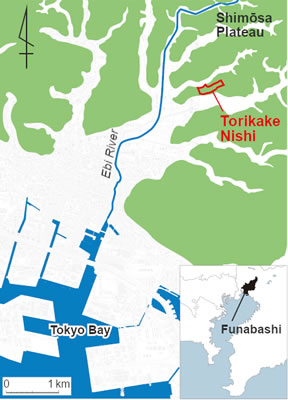
Torikake Nishi Shell Midden and Tokyo Bay The Ebi River flows to the west of the site. Approximately 10,000 years ago the sea level was about 40 m below that of today, and the coastline is inferred to have been roughly 6 km from the site, at a distance from its present position. Adapted from Hakkutsu sareta Nihon rettō 2022 [Excavations in the Japanese Archipelago, 2022] (Bunkachō [Agency for Cultural Affairs], ed., Kyodo News, 2022).

Panoramic view of the site (from the east) The site spreads over a tableland between two small tributaries of the Ebi River. Long and narrow in the east–west direction, the difference in elevation with the valley portions is about 15 m. Adapted from Hakkutsu sareta Nihon rettō 2022 [Excavations in the Japanese Archipelago, 2022] (Bunkachō [Agency for Cultural Affairs], ed., Kyodo News, 2022).
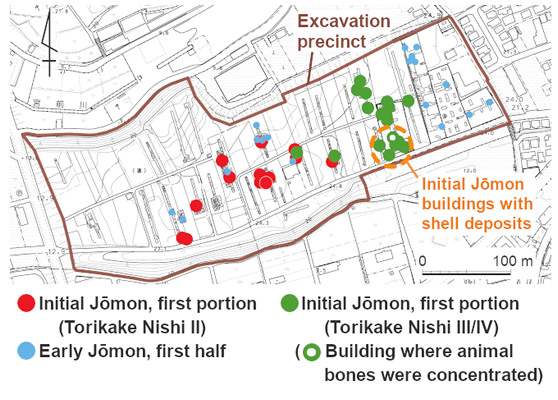
Plan of the distribution of pit-structures Dividing largely into three phases, those of the initial phase are mostly near the site’s center, after which the core shifts to the east. Adapted from Hakkutsu sareta Nihon rettō 2022 [Excavations in the Japanese Archipelago, 2022] (Bunkachō [Agency for Cultural Affairs], ed., Kyodo News, 2022).

Maize weevil impression Injecting silicone into tiny holes in the surface of pottery, making replicas and then examining the shapes, clarified that they were impressions left by maize weevils. The left panel is a silicone replica, and at right is a scanning electron microscope image.
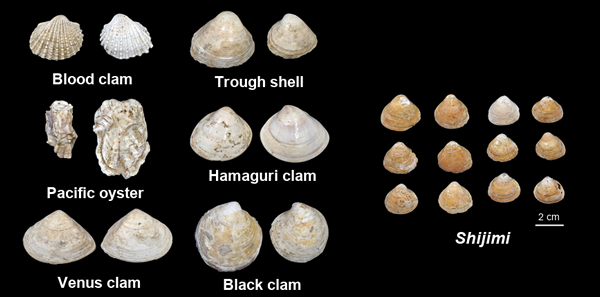
Changes in the shells of the shell middens Shell middens of two phases, the first portion of the Initial and the first half of the Early Jōmon, were confirmed. Comparing the types of shells, the approach of the coastline towards the site from the Initial to the Early Phases can be discerned. Adapted from Hakkutsu sareta Nihon rettō 2022 [Excavations in the Japanese Archipelago, 2022] (Bunkachō [Agency for Cultural Affairs], ed., Kyodo News, 2022).
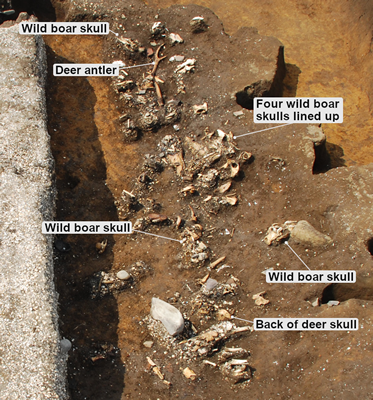
Animal bones discovered in concentrated fashion Skulls of wild boar, which were the central items, were of various ages from juveniles to adults, and had the lower jaws removed. The recovery of shika deer antlers, which were often fashioned into a variety of items, in their original shapes is also unusual. Adapted from Hakkutsu sareta Nihon rettō 2022 [Excavations in the Japanese Archipelago, 2022] (Bunkachō [Agency for Cultural Affairs], ed., Kyodo News, 2022).
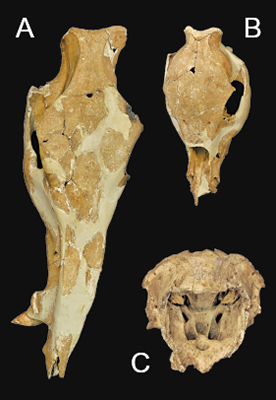
Skulls of wild boar (A, B) and of a shika deer (C) Item A is an adult male, and B is thought to be a juvenile. There are traces of scorching on A, and it is possible that it was exposed to flame as bone. The shika deer skull has had the top of the rear portion of the cranium cut away. Length: A, 40 cm; B, 21.5 cm; C, 12 cm.

Animal teeth ornaments Made of teeth of the sandbar shark. They are perforated with holes of 1–2 mm diameter. Width: 7–11 mm.
A settlement of the largest class in Kantō relating the life of 10,000 years ago
Oldest shell midden in a belt of clustered middens
The Torikake Nishi Shell Midden Historic Site is a settlement accompanied by shell middens of the first portion of Initial Phase and the first half of the Early Phase of the Jōmon period, located atop the Shimōsa Plateau, facing onto Tokyo Bay. The shell midden from the first portion of the Initial Phase (approximately 10,000 years ago) is one of the few nationwide and is the oldest such site among the belt of clustered middens forming the eastern coastal portion of Tokyo Bay.
From 1999, excavations have been conducted in conjunction with land development for residential and other uses, and in the 2008 season the discovery of multiple pit-structures of the first portion of the Initial Jōmon accompanied by shell strata drew attention. From 2017 to 2019, an investigation was carried out to ascertain the extent and contents of the site for the purpose of its preservation. As a result, more than 50 pit-structures of the first portion of the Initial Phase were detected, and it was seen that the pit-structures were distributed in a belt centering on the southern part of the plateau and following its topography over an east–west extent of approximately 300 meters. This is of the largest scale known for the Kantō region of a settlement from the first portion of the Initial Jōmon.
Recovered artifacts telling the daily life and spiritual culture
In the pit-structures discovered in the eastern portion of the site, a shell layer as much as about 70 centimeters thick had accumulated. This consisted of shell and bone discarded as dietary refuse and deposited after the structures had been abandoned, and in addition to wild boar, shika deer, raccoon dog, and Japanese hare, the bones of birds such as pheasants and ducks, and of fish such as carp, sea bream, and sardines, survived in abundance within the shell layer. Among the marine species used for food, more than 99% of the shellfish were Corbicula japonica (shijimi in Japanese), a brackish-water clam that lives in places such as river estuaries where fresh and salt water mix, while the fish species include some living in freshwater regions and others in inlets along the coast, so it is seen that fishing was carried out across wide areas of water. In addition, while the wild boar and shika deer were the core, the wide variety of faunal species seen, including small mammals such as the raccoon dog and hare, and birds like pheasants and ducks, may be called a characteristic of the site.
Moreover, when the recovered carbonized seeds and seed impressions left in the pottery were closely examined, it was seen that nuts such as walnuts, berries including those of the giant dogwood, and legumes such as varieties of soy and adzuki beans were utilized. Further, as impressions were also found of maize weevils, a pest which attacks stored nuts, conditions of a highly sedentary way of life can be inferred.
At one location among the pit-structures, the remains of the skulls of wild boar and shika deer having been gathered and a fire being lit were found beneath the shell layer. At a spot among these where four wild boar skulls were concentrated, three of the skulls were recovered with their axes aligned while pointing alternately in opposite directions, with another skull oriented perpendicularly to these. This manner of recovery, in a unique condition difficult to regard as mere disposal, is totally rare and extremely important as a hint for considering the nature of the rituals and spiritual culture of the people of the time. Also, tools and bodily ornaments using shell and animal bone as materials were recovered in great numbers. In particular, finds of ornaments made from varieties of tusk shells number more than 2,000 items including the raw materials, which is the greatest amount from a single site within Japan.
In the above manner, a great variety of artifacts relating the daily lives and spiritual culture of the first portion of the Initial Phase of the Jōmon period were recovered in abundance from this site. It is a precious site conveying aspects of the rapidly changing natural environment and the lives of people who were adapting to it from approximately 10,000 years ago. (Shirasaki Tomotaka)

